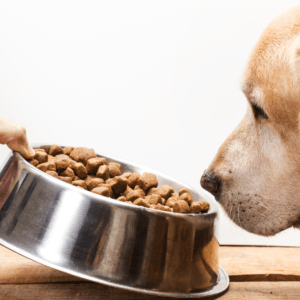
1. Works to Improve Digestive Health
Without a doubt, aiding in the promotion of good digestion in dogs is one of the primary advantages of grain-free dog food. Bloating, changes in stool consistency, and other gastrointestinal issues can occur when dogs digest grains poorly. To help alleviate some of these digestive concerns for your dog, for both their happiness and your convenience, consider switching to grain-free dog food and some dog probiotics. This type of food usually contains a higher proportion of carbs that are simpler to digest and are rich in dietary fibre, such as sweet potatoes.
2. Minimizes the Occurrence of Adverse Reactions
Although it’s still rare, some dogs have allergies to wheat and gluten; therefore, it’s best to keep these foods out of your dog’s diet to lessen the likelihood of an unpleasant immune reaction. Grains have the potential to aggravate canine allergies and intolerances, whether they are severe, chronic, or more subtle conditions like Irritable Bowel Syndrome (IBS).
Grain-free doesn’t always guarantee hypoallergenic, although many people prefer it because it’s less restrictive and dogs often have intolerances to gluten and grains. Ultimately, with so many delicious grain-free options, why put your dog at risk of becoming sick?
It’s a prevalent (but false) assumption that grain-free food means it doesn’t have carbs and hence doesn’t taste good or provide slow-release energy. Carbohydrates in grain-free dog food come from potatoes and other non-cereal sources. Grain is a win-win since it helps people avoid allergies and tastes delicious.
3. Enhancement of Skin and Coat
Excessive itching and dry skin are unpleasant side effects of a grain-heavy diet for dogs. While it’s not always the case, a lacklustre coat might be a result of the poor nutritional quality of many popular big-brand grain kibbles.
Although grains may not be the direct source of the problem here, the fact that grain-based dog meals tend to be nutritionally lacking is. In any case, grain-free diets are typically nutrition-rich foods as they are dense because their main focus is on wellness.
4. Levels of Energy That Are Both High and Reliable
Pause for a moment and try this thinking experiment: how often do you feel exhausted after eating a bowl of branded cereal for breakfast? The reason behind this is that the body burns through the carbs in these cereals fast. Because of how rapidly they are digested, the energy you have received from eating is rapidly depleted when you consume these foods.
In the same vein, grain-based dog food isn’t going to provide your dog with the same level of satisfaction or energy as grain-free dog food because it contains simpler carbs, which release their energy more slowly. In the end, your dog will have more sustained satiety without the erratic energy highs and lows caused by eating grains, which are simple carbs.
5. The Nutritional Profile of Grain-free Dog Foods is Typically More Balanced
When compared to grain-based dog diets, grain-free options tend to have a better balance of carbs, proteins, and fats. That’s because, as said earlier, dog food manufacturers frequently utilize grains as an inexpensive way to bulk out their products. This allows them to sell more of it while keeping production costs low.
Because the health of the dog, not profit maximization or economies of scale, is the primary concern when making grain-free dog food, a more complete and varied kibble (or wet meal) formula is possible.
What is grain-free food?
You should be familiar with the most frequent grains used in dog diets before we go into grain-free options. Some examples are:
- Wheat
- Corn
- Rice
- Oats
- Barley
- Rye
- Soy
Do Carbs Not Exist in Grain-Free Dog Foods?
Grain-free dog foods typically use different carbs such as sweet potatoes, lentils, peas, quinoa, or potatoes instead of grains. Grains are still carbohydrates, even in grain-free diets. Carbohydrate content in grain-free dog food might be comparable to, or even higher than, grain-based dog feeds in some instances.
Is grain-free Dog Food also Gluten-free?
Gluten-free and grain-free do not mean the same thing. Although they may still contain other grains, gluten-free meals do not contain gluten-containing grains like wheat, barley, or rye. And if grain-free foods don’t include any gluten-containing substances, then they might be gluten-free.
Furthermore, research has demonstrated that commercial dog diets frequently contain components that are not entirely devoid of the ones they advertise due to cross-contamination that occurs during production.